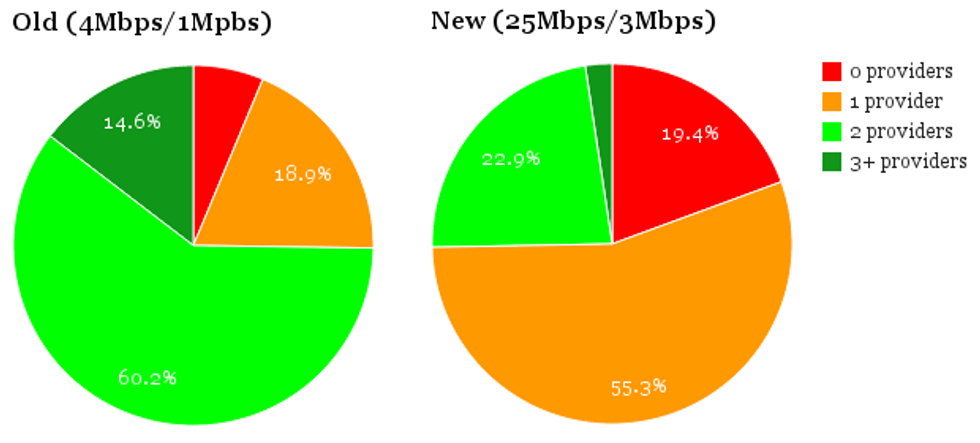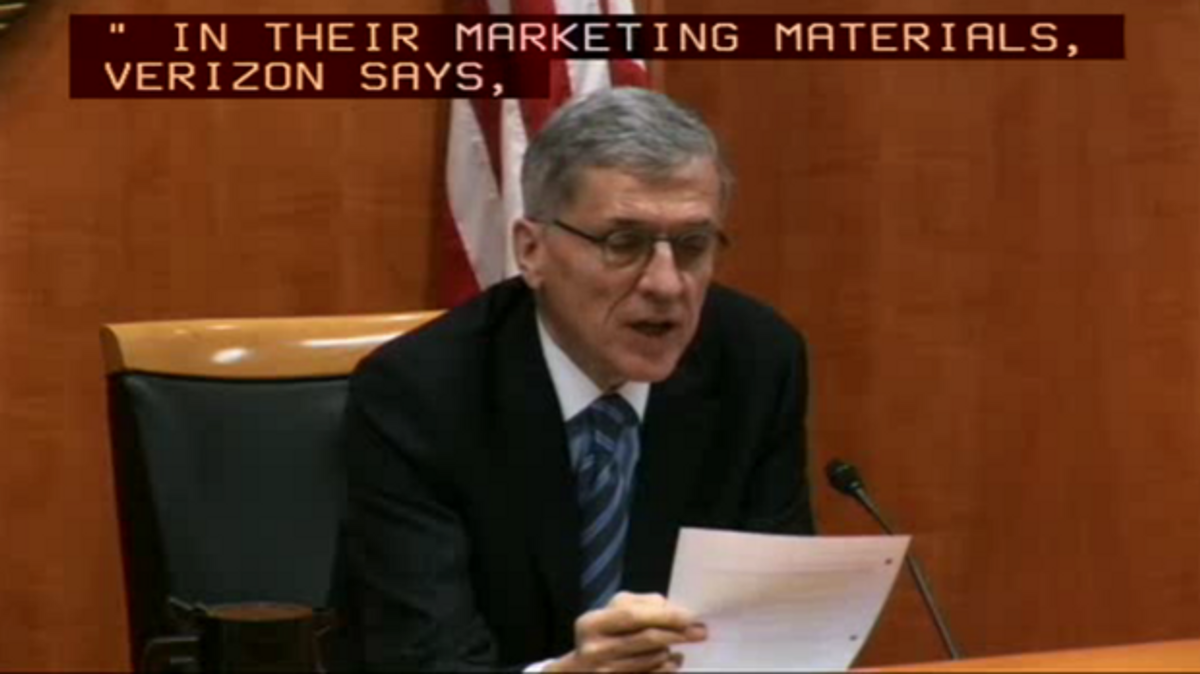Just last week, broadband Internet access in the United States was looking pretty good: 99 percent of Americans had access to broadband speeds [pdf] (even if they weren’t yet taking advantage of them). In addition, competition seemed if not fierce, at least existent: nearly 75 percent of consumers had at least two broadband providers to choose from.
Now, neither statistic is true.
Those numbers were always a bit misleading, because the bar for “broadband” speeds had been set pretty low. The word was a catch-all term, with no differentiating between a 4Mbps DSL connection and a 1Gbps dedicated fiber connection. For many consumers on the slow end of the spectrum, having a broadband Internet connection didn’t mean they could reliably stream HD video.
The FCC decided to address this perception gap between what ISPs are allowed to market as “broadband” and what customers expect these days from a high-speed Internet connection. In yesterday’s open commission meeting, they voted to raise the minimum benchmark speeds to 25Mbps for downloads and 3Mbps for uploads. That’s a significant jump from the previous definition of 4Mbps down and 1Mbps up, which had last been set in 2010.
The change is more than a minor semantic adjustment. Notably, the new definition better highlights the access gap between urban and rural America: while more than 92 percent of urban Americans still have access to the newly classified broadband speeds, only 47 percent of rural Americans do. (About 20 percent of rural Americans lack access to even the old 4Mbps/1Mbps standard of service).
FCC: ISP Marketing Trumps ISP Lobbying
Unsurprisingly, service providers were opposed to the change. Prior to the meeting, the cable industry argued that most consumers don’t really need more bandwidth [pdf], and few fully utilize the bandwidth they do have. But this stands in stark contrast—as FCC Chairman Tom Wheeler demonstrated with a bunch of screenshots—to what ISPs tell their customers when trying to up-sell higher-priced packages and faster speeds.
At the heart of the issue is what customers can expect (and what service providers promise) from different bandwidth ranges. One obvious example is that most broadband consumers expect to be able to stream video, whether it’s from YouTube, Netflix, or Skype. The new definition acknowledges what savvy consumers have known for years—that most DSL connections aren’t really fast enough for streaming high quality video.
Now, the exact speed necessary to stream video is certainly up for debate. In their letter to the FCC, the National Cable & Telecommunications Association helpfully references the Netflix help page which recommends a 5Mbps connection for streaming HD video. They seem to argue that because the old standard is almost fast enough for current-generation services, that should be good enough.
But what they don’t mention is that many customers are often forced to deal with bandwidth at levels far below the ISP’s “maximum advertised speed.” For example, according to the Netflix ISP Speed Index, no U.S. provider even averages 4Mbps. A more optimistic number comes from the most recent Akamai State of the Internet Report, which says that U.S. connection speeds average 11.5Mbps. Both reports show that, in real usage, few customers today get speeds at the new standard.
When existing customers are faced with a connection that can’t do what they want, they’re often encouraged to upgrade to a higher speed (and a higher price). With multiple family members and connected devices, ISPs recommend even more bandwidth. For example, Wheeler showed that both Comcast and Time Warner recommend at least 25Mbps packages for customers who want to stream HD video.
Lack of Competition
The new definition also changes the basic statistics about both broadband access and broadband competition. One of the arguments ISPs have made repeatedly against net neutrality is that there is already a competitive market for broadband. That may have been technically true under the old definition (with many consumers having one DSL and one Cable provider to choose from), but under the new definition, 82 percent of Americans have no choice when it comes to wired Internet providers.

Setting the Bar Too Low?
On the other side of the coin, Commissioner Jessica Rosenworcel suggested that the Commission hadn’t gone far enough. “We can do audacious things if we set big goals, and I think our new threshold, frankly, should be 100Mbps. I think anything short of that shortchanges our children, our future, and our new digital economy,” she said at the meeting. I can only imagine the kind of pushback that limit would have generated.
When ISPs and other opponents argue that we already have all the bandwidth we need (4K video, for what it’s worth, is not considered mainstream, normal, or even necessary), I can’t help but think that they’ve got a rather unimaginative view of technology. Bandwidth limitations continue to hold back the real-world use of two-way video calling and conferencing. It’s also holding back the adoption of more novel telepresence systems.
Finally, I remember visiting the University of California, San Diego a few years ago, where they were investigating what you could do with dedicated point-to-point gigabit connections. My favorite was half of a 4K videoconference room, where the conference table ended in a full-wall projected image. The other half of the the room was in Australia. Not only could you actually see all the other people in the virtual room, but you could see their faces as if they were actually just a few feet away. If and when gigabit connections become ubiquitous, I can't wait to see what else we can come up with.
Joshua J. Romero is a software developer and journalist. A former IEEE Spectrum senior editor, he holds a bachelor’s degree in astronomy and physics from the University of Arizona and a master’s in journalism from New York University.



